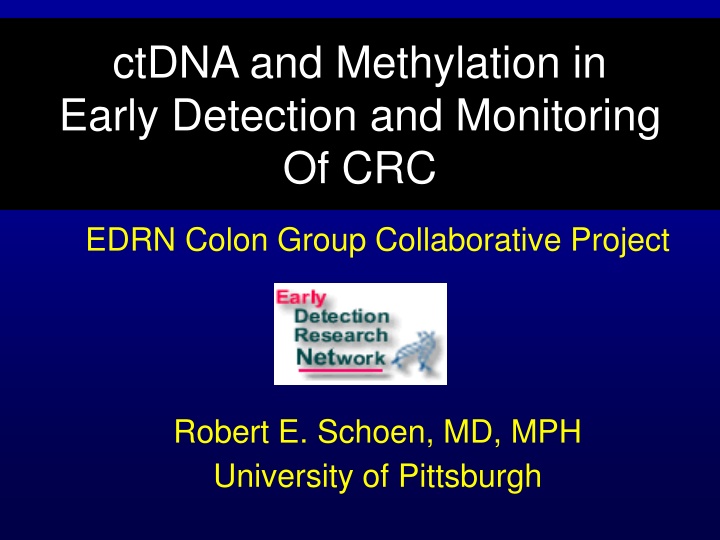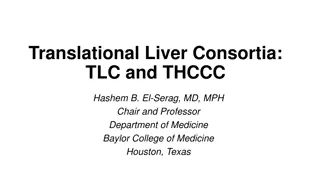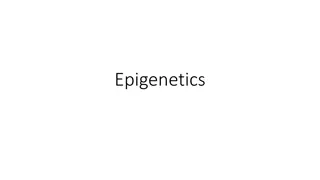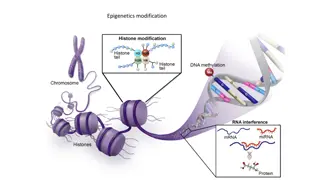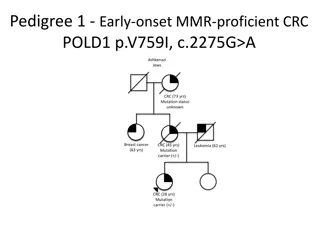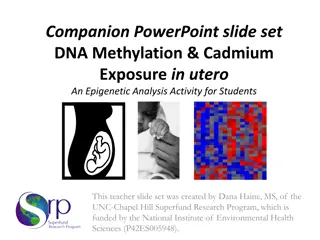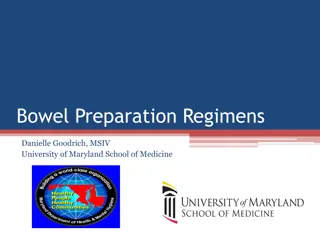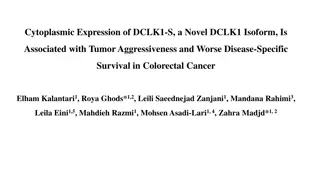Early Detection and Monitoring of Colorectal Cancer using ctDNA and Methylation
Blood tests for colorectal cancer (CRC) screening can enhance compliance and options for testing. Markers like ctDNA and aberrantly methylated genes provide potential for early detection and monitoring of CRC recurrence. By combining these markers in plasma samples processed similarly, a more effective screening and monitoring approach can be developed for CRC patients, including those with regional metastatic disease. Research has shown promising results in using ctDNA levels and aberrantly methylated genes for detecting CRC and monitoring patients post-surgical resection.
Uploaded on Oct 02, 2024 | 2 Views
Download Presentation

Please find below an Image/Link to download the presentation.
The content on the website is provided AS IS for your information and personal use only. It may not be sold, licensed, or shared on other websites without obtaining consent from the author.If you encounter any issues during the download, it is possible that the publisher has removed the file from their server.
You are allowed to download the files provided on this website for personal or commercial use, subject to the condition that they are used lawfully. All files are the property of their respective owners.
The content on the website is provided AS IS for your information and personal use only. It may not be sold, licensed, or shared on other websites without obtaining consent from the author.
E N D
Presentation Transcript
ctDNA and Methylation in Early Detection and Monitoring Of CRC EDRN Colon Group Collaborative Project Robert E. Schoen, MD, MPH University of Pittsburgh
Status Quo A blood test for CRC screening would increase compliance and enhance options for testing Septin 9, a marker of aberrant methylation is an approved blood test, but has limited sensitivity ctDNA, products of apoptotic cell turnover, are small fragments of nucleic acid that could also serve as markers for early detection Markers of aberrantly methylated genes may also be informative Better means of monitoring patients for CRC recurrence are needed
Rationale 1. ctDNA and aberrantly methylated genes are not mutually exclusive and may be complementary 2. Evaluation should occur in samples of plasma collected simultaneously and processed similarly 3. These markers could also have utility in monitoring CRC
Aims of our Future Set Aside Project AIM 1.ctDNA and aberrantly methylated genes can be used together as a primary screening modality for detection of colorectal cancer. AIM 2.ctDNA levels and aberrantly methylated genes can be used for monitoring of CRC patients with regional metastatic disease (stage III). Aim 3:ctDNA levels and aberrantly methylated genes are dynamic and will quantitatively change with surgical resection.
ctDNA in CRC by Cancer Stage Bettegowda et al. Sci Transl Med. 2014 Feb 19;6(224):224ra24.
ctDNA: Localized vs. Advanced Cancer Localized disease 73% Bettegowda et al. Sci Transl Med. 2014 Feb 19;6(224):224ra24.
LETTERS Figure 2 Methyl-BEAMing to detect methylation of the vimentin gene using plasma from colorectal cancer patients. (a) The number of methylated vimentin fragments in 2 ml plasma from healthy, age and sex-matched control patients. (b) The number of methylated vimentin fragments in 2 ml plasma from colorectal cancer patients of various stages. (c) ROC curves based on the number of methylated vimentin fragments for the indicated classes of samples. AUC, area under the curve. (d) ROC curves based on CEA level for the indicated classes of samples. The dotted lines in a,b and c represent one methylated fragment per 2 ml plasma DNA. The dotted line in d represents 5 ng/ml CEA level. compartment becomes bound to the bead. Each bead thereby ends up with thousands of identical copies of the template within its nano- compartment a process similar to that resulting from cloning an individual DNA fragment into a plasmid vector to form a bacterial colony. After PCR, the beads are collected by breaking the emulsion, and their status is individually assessed by incubation with fluorescent hybridization probes. In methyl-BEAMing, the status of harvested beads is interrogated by fluorescent probes that specifically hybridize to bisulfite-converted sequences derived from either methylated or unmethylated parental DNA sequences. Flow cytometry then provides an accurate enumeration of the original template molecules that are methylated or unmethylated within the queried sequence (Fig. 1b). We first tested methyl-BEAMing on mixtures of DNA derived from peripheral blood lymphocytes (unmethylated vimentin) and a colorectal cancer cell line (fully methylated vimentin). We found that the fraction of beads containing methylated vimentin sequences was directly proportional to the fraction of methylated input DNA (R2 = 0.99, Supplementary Fig. 2). Moreover, methyl-BEAMing could accurately detect methylated vimentin DNA in a mixture that contained only a single DNA molecule of methylated vimentin exon 1 sequences mixed with 1,000 copies of unmethylated vimentin exon 1 sequences (that is, detection of 0.1% of methylation target). In contrast, in parallel assays, a previously optimized methylation- specific PCR assay did not detect methylated templates when the frac- tion of methylated fragments was <6.2% (Supplementary Table 1). Methyl-BEAMing thus enabled accurate detection of a single copy of Methylated Vimentin vs. CEA in Detection of CRC by Stage c1.0 d1.0 0.8 0.8 Sensitivity Sensitivity 0.6 0.6 Methyl-BEAMing Duke s A, AUC = 0.77 Duke s B, AUC = 0.82 Duke s C, AUC = 0.67 Duke s D, AUC = 0.95 All stages, AUC = 0.81 0.4 0.4 CEA Duke s A, AUC = 0.42 Duke s B, AUC = 0.55 Duke s C, AUC = 0.56 Duke s D, AUC = 0.97 All stages, AUC = 0.63 0.2 0.2 0 0 0 0.2 0.4 0.6 0.8 1.0 0 0.2 0.4 0.6 0.8 1.0 1 specificity 1 specificity methylated vimentin sequences in a mixture and enhanced overall technical sensitivity for detecting methylated vimentin exon 1 DNA by at least 62-fold relative to methylation-specific PCR. Cancer biomarkers, particularly circulating molecules, can be useful for early detection or monitoring of disease after therapy. The ability to detect and count a single molecule of methylated DNA suggested that methyl-BEAMing could be applied for such purposes. To determine the sensitivity and specificity of methyl- BEAMing in plasma samples, we evalu- ated 191 samples, 81 from patients with colorectal cancer and 110 from age- and sex-matched controls. The total amount of DNA in the plasma was somewhat higher in patients with cancer than in the cancer- free controls, as expected2 (Supplementary Fig. 3). The average fraction of methyl- ated vimentin fragments was very low in the healthy controls (mean value of Figure 3 Methyl-BEAMing to detect methylation of the vimentin gene using fecal DNA from colorectal tumor patients. (a) The percentage of methylated vimentin fragments in 4 g feces from healthy, age and sex-matched control patients. (b) The percentage of methylated vimentin fragments in 4 g feces from patients with colorectal adenomas. (c) The fraction of methylated vimentin fragments in 4 g feces from patients with colorectal carcinomas (red, Duke s A or B; blue, Duke s C or D). The dotted line represents 2% methylated fragments. (d) ROC curves based on the fraction of methylated vimentin fragments for the indicated classes of samples. VOLUME 27 NUMBER 9 SEPTEMBER 2009 NATURE BIOTECHNOLOGY 860
ctDNA Detects Minimal Residual Disease and Predicts Recurrence in Stage II Colon Cancer Jeanne Tie, Yuxuan Wang, Cristian Tomasetti, Lu Li, Simeon Springer, Isaac Kinde, Natalie Silliman, Mark Tacey, Hui-Li Wong, Michael Christie, Suzanne Kosmider, Iain Skinner, Rachel Wong, Malcolm Steel, Ben Tran, Jayesh Desai, Ian Jones, Andrew Haydon, Theresa Hayes, Tim J. Price, Robert L. Strausberg, Luis A. Diaz Jr., Nickolas Papadopoulos, Kenneth W. Kinzler, Bert Vogelstein and Peter Gibbs Tie. Science Translational Medicine 2016
ctDNA in Stage II-CRC N=250, post-op and serial plasma 23% adj chemo Rx at clinician direction Targeted 15 genes using safe-SeqS 20/231 +ctDNA post op (9 p53, 8 APC, 3 KRAS) Median f/u 27 mo 34 (14.8%) radiologic recurrence 27/178 (15%) no chemo Rx 7/52 (13%) with chemo Rx Tie, Science Trans Med 2016
ctDNA in Stage II-Results No Chemo +ctDNA Recurrence free survival (RFS): HR=18 ctDNA helpful in both low and high risk by clinical pathologic characteristics CEA did not predict RFS
Recurrence Free Survival (RFS) in patients not treated with adjuvant chemotherapy Jeanne Tie et al., Sci Transl Med 2016;8:346ra92
Recurrence Free Survival (RFS) in patients not treated with adjuvant chemotherapy by CEA level
Serial ctDNA status up to radiological recurrence ctDNA levels in patients not treated with chemo with positive ctDNA post op up to time of radiologic recurrence (N=9) Lead time to radiologic recurrence for ctDNA and CEA
Conclusions ctDNA is a marker for recurrence in patients with stage II CRC ctDNA findings discriminate within clinicopathologic subgroups
Aim 1 Evaluation ctDNA and Aberrant Methlylation in Stage III and IV ctDNA evaluated via SafeSeqs sequencing using panel of mutations (61 amplicons in 16 genes 1999 positions Panel of methylation markers, EVL, NTRK3, VIM and others via NGS 40 CRC and 40 controls
Aim 2 Evaluation in Stage III Patients Undergoing Monitoring for Recurrence Assess ctDNA and methylation as prognostic markers for disease-free and overall survival Use ctDNA results as basis for selection: Assess 15 patients who begin ctDNA negative and recur, and 10 patients who begin as ctDNA positive Isolate tumor DNA from blocks to correlate to plasma findings
Aim 3 Evaluate Dynamic Change in ctDNA and Methylation with Surgery Evaluate 15 patients pre and post surgery for change in ctDNA and methylation markers Know ctDNA decreases post-op, but hasn t been tested formally with markers of aberrant methylation
End Result 1. Assess ctDNA and aberrantly methylated genes for screening and monitoring of CRC 2. Evaluation will occur in equal volume of plasma collected similarly
Advanced Adenomas Defined as adenomas 1cm, tubulovillous or villous histology, or HGD Higher likelihood of harboring CRC Subjects with them have higher likelihood of developing CRC Most important precursor of CRC to detect Non-invasive markers such as FIT, s-DNA limited sensitivity for AA
Advanced Adenoma Supplement Rationale Using BEAMing (2005) could only detect 1/11 patients with an advanced adenoma Issue has not been evaluated using current technology of ctDNA
AA Supplement 15 pre-colonoscopy subjects with Advanced adenoma and 8 ml plasma 41 pre-surgical subjects with Advanced adenoma and 8 ml plasma Readying these for evaluation
ctDNA Detects Minimal Residual Disease and Predicts Recurrence in Stage II Colon Cancer Jeanne Tie, Yuxuan Wang, Cristian Tomasetti, Lu Li, Simeon Springer, Isaac Kinde, Natalie Silliman, Mark Tacey, Hui-Li Wong, Michael Christie, Suzanne Kosmider, Iain Skinner, Rachel Wong, Malcolm Steel, Ben Tran, Jayesh Desai, Ian Jones, Andrew Haydon, Theresa Hayes, Tim J. Price, Robert L. Strausberg, Luis A. Diaz Jr., Nickolas Papadopoulos, Kenneth W. Kinzler, Bert Vogelstein and Peter Gibbs Tie. Science Translational Medicine 2016
Collection of clinical samples and follow-up data 250 patients with Stage II colon cancer Ineligible N=19 Use of adjuvant chemo at clinician s discretion Chemo (N=57) No Chemo (N=79) 4-10 weeks post-op blood samples (N=231) Tumor Tissue N=231 3-monthly follow-up blood draw in a subset of patients (N=167) Target sequencing of 15 genes Clinical f/u q3 months CT q6months - ctDNA quantification - CEA analysis N=230 Mutations identified in tumors (N=230) Final N=230 Recurrence = 34 No Recurrence = 196
ctDNA in Stage II-CRC N=250, post-op and serial plasma 23% adj chemo Rx at clinician direction Targeted 15 genes using safe-SeqS 20/231 +ctDNA post op (9 p53, 8 APC, 3 KRAS) Median f/u 27 mo 34 (14.8%) radiologic recurrence 27/178 (15%) no chemo Rx 7/52 (13%) with chemo Rx Tie, Science Trans Med 2016
ctDNA in Stage II-Results No Chemo +ctDNA Recurrence free survival (RFS): HR=18 ctDNA helpful in both low and high risk by clinical pathologic characteristics CEA did not predict RFS
Recurrence Free Survival (RFS) in patients not treated with adjuvant chemotherapy Jeanne Tie et al., Sci Transl Med 2016;8:346ra92
Recurrence Free Survival (RFS) in patients not treated with adjuvant chemotherapy Jeanne Tie et al., Sci Transl Med 2016;8:346ra92
Recurrence Free Survival (RFS) in patients not treated with adjuvant chemotherapy by CEA level
ctDNA in Stage II-Results Post chemo +ctDNA: worse RFS: HR=11 Radiologic recurrence: +ct DNA (23/27) vs. CEA (11/27) 85% vs. 41% (p=.002) Time from detection to recurrence (ctDNA 167 days vs. CEA 61 days), p=.04
Serial ctDNA status up to radiological recurrence ctDNA levels in patients not treated with chemo with positive ctDNA post op up time of radiologic recurrence (N=9) Lead time to radiologic recurrence for ctDNA and CEA
ctDNA status before, during, and after adjuvant chemotherapy with positive post op ctDNA (N=6) 3 of 4 patients whose ctDNA became negative post chemo remained recurrence free
ctDNA in Stage II CRC - Conclusions Sensitivity (+ ctDNA) of predicting recurrence at 36 months is 48% 97% of subjects who did not recur had negative ctDNA post op + ctDNA high risk radiologic recurrence w/o chemo (none at 3 yrs by KM) - ctDNA low risk radiologic recurrence w/o chemo (90% RFS at 3 yrs) Personalized approach to patient management with ct DNA ct DNA better than CEA
Conclusions ctDNA is a marker for recurrence in patients with stage II CRC ctDNA findings discriminate within clinicopathologic subgroups
